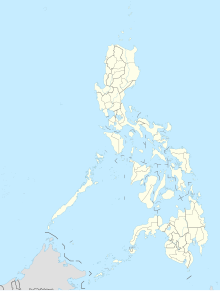Ayub (cave)
Coordinates: 5 ° 55 ′ 36.2 " N , 124 ° 57 ′ 37.5" E
The Ayub caves in the south of the island of Mindanao ( Philippines ) were used as a burial place at the turn of the times and during excavations they produced over 150 burial vessels whose lids were human-shaped.
The history of the Philippines is very little research. So far it has been difficult to show developments and identify individual cultures. The discovery of an approx. 2000 year old cemetery in the Ayub caves is therefore of particular importance.
49 completely preserved and approximately 100 fragments of heads and the associated burial vessels were found. Some of the lids were life-size. The actual vessel was often undecorated, but could also have hints of arms and genitals. There are representations of jewelry. Some of the heads were unpainted, while others are red and black in color.
Not all of the lids found here were human-shaped. There are also examples of simple round lids with four handles. The bones of those buried here were found in the vessels. As grave goods were smaller vessels, glass beads, bracelets, clay beads and shell jewelry. These were found with the corpses in the vessels.
Comparable burials are also known from other sites in the Philippines.
literature
- E. Dizon: Maguindanao prehistory: Focus on the archeology of the anthropomorphic potteries at Pinol, Maitum, South Cotabato, Mindanao, Philippines , In: National Museum Papers 4 (1993), pp. 1-21
